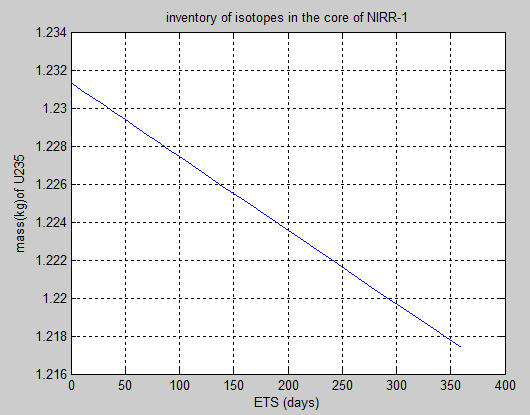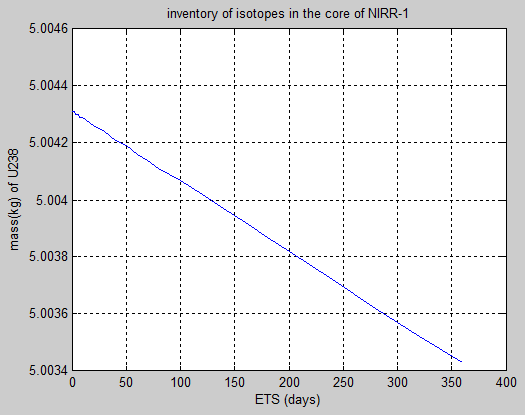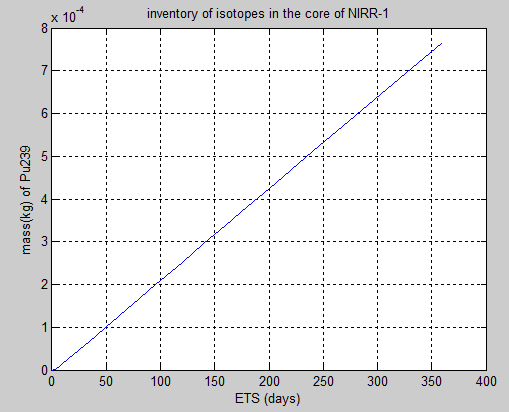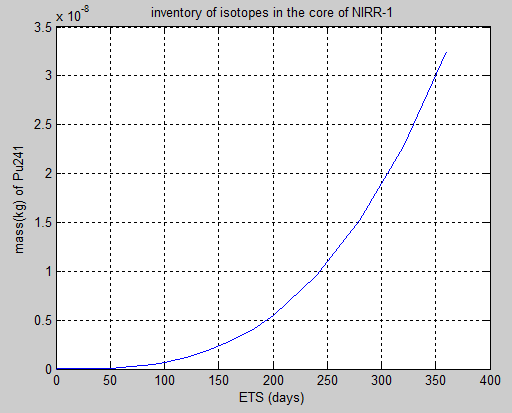-
Paper Information
- Next Paper
- Paper Submission
-
Journal Information
- About This Journal
- Editorial Board
- Current Issue
- Archive
- Author Guidelines
- Contact Us
Journal of Nuclear and Particle Physics
p-ISSN: 2167-6895 e-ISSN: 2167-6909
2016; 6(1): 1-5
doi:10.5923/j.jnpp.20160601.01

Determination of the Comsumption Rate in the Core of the Nigeria Research Reactor-1 (NIRR-1) Fuelled with 19.75% UO2 Material
Rabba J. A. 1, Onimisi M. Y. 2, Salawu A. 1, Samson D. O. 3
1Department of Physics, Federal University Lokoja, Kogi State, Nigeria
2Department of Physics, Nigeria Defence Academy, Kaduna, Nigeria
3Department of Physics, University of Abuja, Abuja, Nigeria
Correspondence to: Rabba J. A. , Department of Physics, Federal University Lokoja, Kogi State, Nigeria.
| Email: |  |
Copyright © 2016 Scientific & Academic Publishing. All Rights Reserved.
This work is licensed under the Creative Commons Attribution International License (CC BY).
http://creativecommons.org/licenses/by/4.0/

In this work, the VENTURE PC coding system was used to perform the burnup/depletion analysis of the Nigeria Research Reactor-1 (NIRR-1) core enriched with 19.75% UO2 material. The venture module of the venture pc code performs the neutronic part of the calculation while the burner code module of the same venture pc code performs the depletion calculation. Result indicated that the total estimate of U235 consumption in 200 days of NIRR-1 operation is approximately 7.75g in the LEU, which implies that the present NIRR-1 system and the proposed LEU core have a burnup of less than 1% in 200 days of reactor operation.
Keywords: Consumption, Burnup, Fuel, Depletion, Reactor, Isotope, Fissile
Cite this paper: Rabba J. A. , Onimisi M. Y. , Salawu A. , Samson D. O. , Determination of the Comsumption Rate in the Core of the Nigeria Research Reactor-1 (NIRR-1) Fuelled with 19.75% UO2 Material, Journal of Nuclear and Particle Physics, Vol. 6 No. 1, 2016, pp. 1-5. doi: 10.5923/j.jnpp.20160601.01.
1. Introduction
- The Nigeria Research Reactor-1 (NIRR-1) is the first nuclear reactor in Nigeria and it is sited at the Centre for Energy Research and Training (CERT), Ahmadu Bello University, Zaria. It was acquired specifically for neutron activation analysis (NAA), radioisotope production, training and research (Balogun and Jonah, 2005). Like all commercial Miniature Neutron Source Reactors (MNSR), NIRR-1 is a low power, tank-in-pool type research reactor fueled with about 1kg of High Enriched Uranium material. The Nigeria Research reactor, which was critical for the first time on 03 February, 2004 is presently in its first fuel cycle (Balogun and Jonah, 2004) and it has been operated safely since 2005 to date. Performing depletion analysis for any reactor system is extremely important in predicting the long term changes in isotopic composition of the nuclear fuel as well as the buildup of some important fission products. Therefore, reactors are usually designed with excess reactivity for it to be operated successfully from the time of fresh fuel loading to the time of the desired final exposure or shutdown of the reactor system (Sampong et al, 1999).During reactor operation, the fuel material in the core of the system deplete with time due to consumption for fission/absorption reaction within the reactor system. For the present Nigeria Research Reactor-1 (NIRR-1), burnup calculations can be used to predict long- term changes in the isotopic composition of its fuel material, caused by exposure to neutrons of different flux level, leading to fuel irradiation in the core of the system during reactor operation. NIRR-1 like other Commercial MNSRs has single control rod performing all safety functions. One of the feasibility studies conducted locally here in Nigeria have shown that 19.75% UO2 material can be used to replace the present HEU fuel in the core of the system without any significant changes in NIRR-1 performance.As fuel depletes in a typical Miniature Neutron Source Reactor (MNSR) like NIRR-1, top Beryllium shim plates are added periodically to maintain the excess reactivity for continuing operation. The maximum allowed excess reactivity at the beginning of each operating cycle is 4mk (Liaw and Matos, 2005). The present NIRR-1 system is fuelled with UAl4-Al enriched to 90.2% U235 and the result from various depletion calculations has shown that the system can be operated with a burnup of less than 1% for a period of 10 years (Salawu, 2013). In this work, we performed a similar depletion analysis for NIRR-1 system using UO2 enriched to 19.75% as fuel material. This is in line with the current global efforts to determine a suitable fuel material to convert the core of research reactor system from high enriched uranium (HEU) to low enriched uranium (LEU) fuel, without any significant reduction in reactor performance. The nuclear analysis tool that was used to perform this calculation is the BUNRER Code module of the VENTURE PC, a deterministic code manufactured by the Argon National Laboratory in the USA. (Salawu, 2013). A licensed user of the code performed the calculations to generate the inventory (in kilogram) of the isotopes in the system at different times steps. A short Matlab code was written to produce the graphical visualization of the generated data for various isotopes of interest in the core of the system.
2. Methodology
- The VENTURE module and the BURNER code module are two modules of VENTURE PC code system that are used in this work to perform burnup/depletion analysis of the NIRR-1 core.While the venture module performs the neutronic part of the calculation, the burner code module performs the depletion calculation.The quasi static depletion process was used to perform the calculation. In this method, the code did some flux calculation over a certain period of time called the “time step” and then did depletion calculation which produces a new isotope density data for the next flux calculation (i.e. flux calculation followed by depletion calculation, followed by another flux calculation followed by another depletion calculation etc) (Salawu, 2013). A total of 9 times steps were used in this calculation and the different times used to generate a smooth curve were 1day, 10days, 20days, and 40days.Some of the data prepared for the burner code input entry contain information such as names of nuclide that fission, fission product and their order in the decay chain, decay constant of some fission products and their fission yields. Nineteen nuclides were examined in the exposure calculation and two were created artificially. Five out of this nuclide can fission; some were product from fission as well as nuclides from the decay of fission product. The decay constant and their various fission product yield data that is used to perform the calculations were extracted from the online database such as JANIS 3.3 or WIMS Library Update Project and the wolframalpha.com/input (wolframalpha.com/input).
3. Result and Discussion
- The result of the burnup calculation using the burner code module of the VENTURE PC code for the proposed LEU core selected for NIRR-1 system is as shown in the figures below.The total estimate of U235 consumption in 200 days of NIRR-1 operation is approximately 7.75g in the LEU, which implies that the present NIRR-1 system and the LEU core have a burnup of less than 1% in 200days of reactor operation and this will be equivalent to 11 years of NIRR-1 operation (i.e. 9 hours per week) (fig. 1)
 | Figure 1. Estimated daily changes in U235 concentration during NIRR-1 operation using 19.75% UO2 material as fuel |
 | Figure 2. Estimated daily changes in U238 concentration during NIRR-1 operation using 19.75% UO2 material as fuel |
 | Figure 3. Estimate of Pu239 produced in the NIRR-1 core during reactor operation using 19.75% UO2 material as fuel |
 | Figure 4. Estimate of Pu220 produced in the NIRR-1 core during reactor operation using 19.75% UO2 material as fuel |
 | Figure 5. Estimate of Pu239 produced in the NIRR-1 core during reactor operation using 19.75% UO2 material as fuel |
4. Conclusions
- The amount of fuel material in the core of a reactor system constantly depletes or decreases with time during reactor operation. For a reactor to be operated for a long period of time, fuel in excess of the amount needed to maintain criticality is added during the construction of the reactor system. The positive reactivity due to the excess fuel must be balanced with negative reactivity from neutron-absorbing material in the core of the system. The results from the burnup calculation performed in this work shows that the Nigeria Research Reactor-1 (NIRR-1) when fuelled with 19.75% UO2 material, will have a burnup of less than 1% in 10 years of reactor operation at 9 hours per week. The buildup of fissile isotope such as Pu239 and Pu240 in the 19.75% UO2 fuelled core is negligible small.
ACKNOWLEGDEMENTS
- The author is very grateful to Federal University Lokoja, Kogi State Nigeria for sponsoring the research, Dr. M.Y. Onimisi for all the technical assistance he rendered and supervising the work and Dr. A. Salawu for providing the computer code used in this research and also a co-supervisor to this work. This work is part of a research conducted by Mr J.A. Rabba for his concluded M.Sc. Program at the Postgraduate school of the Nigeria Defence Academy, Kaduna, Nigeria.
 Abstract
Abstract Reference
Reference Full-Text PDF
Full-Text PDF Full-text HTML
Full-text HTML